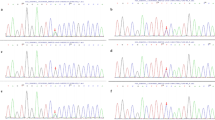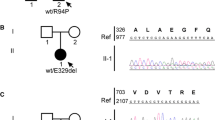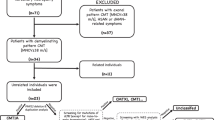Abstract
We identified the main features of Charcot–Marie–Tooth (CMT) disease, type 4F, caused by a periaxin gene (PRX) mutation in Japanese patients. Periaxin is known as one of the key myelination molecules, forming tight junction between myelin loop and axon. We collected 427 DNA samples from individuals with CMT or CMT-related neuropathy, negative for PMP22 duplication. We investigated PRX mutations using a purpose-built resequencing array screen during the period 2006–2012. We detected two types of PRX mutations in three patients; one patient showed a novel homozygous p.D651N mutation and the other two showed homozygous p.R1070X mutation. All PRX mutations reported so far have been of nonsense or frameshift type. In this study, we found homozygous missense mutation p.D651N. Aspartate 651 is located in a repeat domain; its position might indicate an important function. PRX mutations usually lead to early-onset, autosomal-recessive demyelinating CMT neuropathy 4F (CMT4F) or Dejerine–Sottas disease; their clinical phenotypes are severe. In our three patients, the onset of the disease was at the age of 27 years or later, and their clinical phenotypes were milder compared with those reported in previous studies. We showed a variation of clinical phenotypes for CMT4F caused by a novel, nonsense PRX mutation.



Similar content being viewed by others
References
Skre H (1974) Genetic and clinical aspects of Charcot–Marie–Tooth’s disease. Clin Genet 6(2):98–118
Pareyson D, Marchesi C (2009) Diagnosis, natural history, and management of Charcot–Marie–Tooth’s disease. Lancet Neurol 8(7):654–667
Boerkoel CF, Takashima H, Stankiewicz P, Garcia CA, Leber SM, Rhee-Morris L, Lupski JR (2001) Periaxin mutations cause recessive Dejerine–Sottas neuropathy. Am J Hum Genet 68(2):325–333
Guilbot A, Williams A, Ravisé N, Verny C, Brice A, Sherman DL, Brophy PJ, LeGuern E, Delague V, Bareil C, Mégarbané A, Claustres M (2001) A mutation in periaxin is responsible for CMT4F, an autosomal recessive form of Charcot–Marie–Tooth disease. Hum Mol Genet 10(4):415–421
Takashima H, Boerkoel CF, De Jonghe P, Ceuterick C, Martin JJ, Voit T, Schröder JM, Williams A, Brophy PJ, Timmerman V, Lupski JR (2002) Periaxin mutations cause a broad sectrum of dymyelinating neuropathies. Ann Neurol 51:709–715
Marchesi C, Milani M, Morbin M, Cesani M, Lauria G, Scaioli V, Piccolo G, Fabrizi GM, Cavallaro T, Taroni F, Pareyson D (2010) Four novel cases of periaxin-related neuropathy and review of the literature. Neurology 75(20):1830–1838
Di X, Matsuzaki H, Webster TA, Hubbell E, Liu G, Dong S, Bartell D, Huang J, Chiles R, Yang G, Shen MM, Kulp D, Kennedy GC, Mei R, Jones KW, Cawley S (2005) Dynamic model based algorithms for screening and genotyping over 100 K SNPs on oligonucleotide microarrays. Bioinformatics 21(9):1958–1963
Otagiri T, Sugai K, Kijima K, Arai H, Sawaishi Y, Shimohata M, Hayasaka K (2006) Periaxine mutation in Japanese patients with Charcot–Marie–Tooth disease. J Hum Genet 51(7):625–628
Delague V, Bareil C, Tuffery S, Bouvagnet P, Chouery E, Koussa S, Maisonobe T, Loiselet J, Mégarbané A, Claustres M (2000) Mapping of a new locus for autosomal recessive demyelinating Charcot–Marie–Tooth disease to 19q13.1–13.3 in a large consanguineous Lebanese family: exclusion of MAG as a candidate gene. Am J Hum Genet 67(1):236–243
Banchs I, Casasnovas C, Albertí A, De Jorge L, Povedano M, Montero J, Martínez-Matos JA, Volpini V (2009) Diagnosis of Charcot–Marie–Tooth disease. J Biomed Biotechnol 2009:985415
Kijima K, Numakura C, Shirahata E, Sawaishi Y, Shimohata M, Igarashi S, Tanaka T, Hayasaka K (2004) Periaxin mutation cases early-onset but slow-progressive Charcot–Marie–Tooth disease. J Hum Genet 49(7):376–379
Parman Y, Battaloglu E, Baris I, Bilir B, Poyraz M, Bissar-Tadmouri N, Williams A, Ammar N, Nelis E, Timmerman V, De Jonghe P, Najafov A, Deymeer F, Serdaroglu P, Brophy PJ, Said G (2004) Clinicopathological and genetic study of early-onset demyelinating neuropathy. Brain 127:2540–2550
Kabzińska D, Drac H, Sherman DL, Kostera-Pruszczyk A, Brophy PJ, Kochanski A, Hausmanowa-Petrusewicz I (2006) Charcot–Marie–Tooth type 4F disease caused by S399fsX410 mutation in the PRX gene. Neurology 66(5):745–747
Auer-Grumbach M, Fischer C, Papić L, John E, Plecko B, Bittner RE, Bernert G, Pieber TR, Miltenberger G, Schwarz R, Windpassinger C, Grill F, Timmerman V, Speicher MR, Janecke AR (2008) Two novel mutations in the GDAP1 and PRX genes in early onset Charcot–Marie–Tooth syndrome. Neuropediatrics 39(1):33–38
Baránková L, Sisková D, Hühne K, Vyhnálková E, Sakmaryová I, Bojar M, Rautenstrauss B, Seeman P (2008) A 71-nucleotide deletion in the periaxin gene in a Romani patient with early-onset slow progressive demyelinating CMT. Eur J Neurol 15(6):548–551
Sevilla T, Jaijo T, Nauffal D, Collado D, Chumillas MJ, Vilchez JJ, Muelas N, Bataller L, Domenech R, Espinós C, Palau F (2008) Vocal cord paresis and diaphragmatic dysfunction are severe and frequent symptoms of GDAP1-associated neuropathy. Brain 131(11):3051–3061
Benson B, Sulica L, Guss J, Blitzer A (2010) Laryngeal neuropathy of Charcot–Marie–Tooth disease: further observations and novel mutations associated with vocal fold paresis. Laryngoscope 120(2):291–296
Dytrych L, Sherman DL, Gillespie CS, Brophy PJ (1998) Two PDZ domain proteins encoded by the murine periaxin gene are the result of alternative intron retention and are differentially targeted in Schwann cells. J Biol Chem 273(10):5794–5800
Sherman DL, Fabrizi C, Gillespie CS, Brophy PJ (2001) Specific disruption of a Schwann cell dystrophin-related protein complex in a demyelinating neuropathy. Neuron 30(3):677–687
Court FA, Sherman DL, Pratt T, Garry EM, Ribchester RR, Cottrell DF, Fleetwood-Walker SM, Brophy PJ (2004) Restricted growth of Schwann cells lacking Cajal bands slows conduction in myelinated nerves. Nature 431(7005):191–195
Gillespie CS, Sherman DL, Fleetwood-Walker SM, Cottrell DF, Tait S, Garry EM, Wallace VC, Ure J, Griffiths IR, Smith A, Brophy PJ (2000) Peripheral demyelination and neuropathic pain behavior in periaxin-deficient mice. Neuron 26(2):523–531
Court FA, Hewitt JE, Davies K, Patton BL, Uncini A, Wrabetz L, Feltri ML (2009) A laminin-2, dystroglycan, utrophin axis is required for compartmentalization and elongation of myelin segments. J Neurosci 29(12):3908–3939
Gibbs S, Fijneman R, Wiegant J, van Kessel AG, van De Putte P, Genomics BC (1993) Molecular characterization and evolution of the SPRR family of keratinocyte differentiation markers encoding small proline-rich proteins. Genomics 16(3):630–637
Hohl D, de Viragh PA, Amiguet-Barras F, Gibbs S, Backendorf C, Huber M (1995) The small proline-rich proteins constitute a multigene family of differentially regulated cornified cell envelope precursor proteins. J Invest Dermatol 104(6):902–909
Acknowledgments
We thank the families described in this report for their cooperation. This study was supported in part by grants from the Nervous and Mental Disorders and Research Committee for CMT Disease, Neuropathy, Ataxic Disease and Research on Applying Health Technology of the Japanese Ministry of Health, Welfare and Labour (H.T.)
Conflicts of interest
H.T. has received the royalty for CMT genetic diagnosis PRX gene from Athena diagnostics.
Author information
Authors and Affiliations
Corresponding author
Rights and permissions
About this article
Cite this article
Tokunaga, S., Hashiguchi, A., Yoshimura, A. et al. Late-onset Charcot–Marie–Tooth disease 4F caused by periaxin gene mutation. Neurogenetics 13, 359–365 (2012). https://doi.org/10.1007/s10048-012-0338-5
Received:
Accepted:
Published:
Issue Date:
DOI: https://doi.org/10.1007/s10048-012-0338-5




